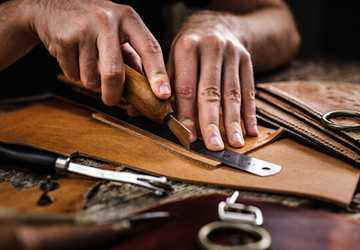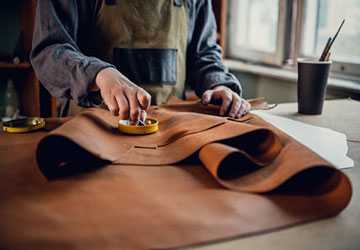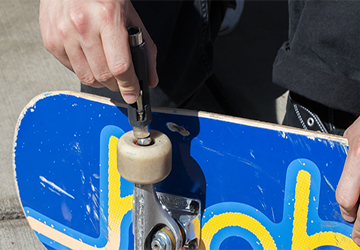Leather has an irresistible, timeless appeal. The smell, the texture, and the durability – it's no wonder leather goods never go out of style. But have you ever thought about making your unique leather goods?
It's a satisfying and practical craft that allows you to create personalized items that will last a lifetime. In this guide, we'll walk you through the process step-by-step, without any fancy corporate jargon, just the simple, spartan details you need to get started.
Materials you need
Before you start crafting, you need suitable materials. This is what you need:
Leather: the star of the show. There are many types of leather, from cowhide to suede. Start with pieces that fit your project.
Cutting tools: You'll need a sharp knife or leather scissors to clean the leather.
Edge Tools: These tools will help you smooth and round the edges of your leather pieces. Sandpaper or a unique edging tool will do.
Needle and Thread: Strong needles and waxed threads are essential for sewing leather goods.
Ruler and tape measure: When working with leather, accurate measurements are crucial.
Awl: An awl is a sharp tool used to make holes in leather, especially for sewing.
Hole Punch: These are handy for punching evenly spaced holes for hardware or shoelaces.
Fixture: Holds a part in place while it is being machined.
Dyes and Finishes: Add color and protect your leather goods.
Now that you have the materials, we can make some unique leather items.

Step 1: Design your project
Every great piece of leather craftsmanship begins with design. Take a piece of paper and sketch out your idea. Consider the type of leather you choose and its unique properties, whether a wallet, belt, bag or something else; a clear plan can make manufacturing more manageable.
Consider the following design aspects:
Dimensions and Dimensions: Determine the sizes and dimensions of your project and make sure it is practical and functional.
Snaps and Fasteners: Determine what type of fastener or fasteners your project requires. It can be buttons, zippers, images, or buckles.
Pockets and Compartments: When building a bag or purse, consider the number and arrangement of pockets or compartments based on your needs.
Decorative elements: Plan decorative features such as embossing, engraving, or sewing patterns to make your project unique.
Step 2: Cut the Leather
Once the design is complete, place it on the leather and cut along the lines with a sharp knife or leather scissors. Take the time to make precise cuts to ensure your piece fits perfectly.
Step 3: Smooth the Edges
Rough edges can make your leather goods look unprofessional and cause discomfort when handling them. Use sandpaper or an edging tool to smooth and round the edges of the cut piece. Not only does this make them look better, but it also prevents them from wearing out. Be sure to work in one direction to get an even edge.
Step 4: Punch holes for sewing
You will need to drill evenly-spaced holes to sew the leather pieces together. To do this, use an awl or a thorn. Make sure the holes are correctly aligned to ensure a clean surface. If your project includes multiple layers of leather, use wing dividers or calipers to mark evenly spaced stitching lines before drilling.
Step 5: Sew it together
Thread a heavy-duty needle with waxed thread, adding strength and durability to the stitch. Starting at one end, carefully sew the pieces together. Sewing leather can be rugged. So take your time to make sure your seams are even and tight. You can use a sewing needle or clamps to keep your work steady and to maintain even stitch tension.
Consider these sewing techniques:
Saddle stitch: In this method, two needles (one at each end of the thread) are passed through the same hole from opposite sides. It's sturdy and visually appealing.
This is a simple yet effective stitch where the needle goes in and out of the leather along the seam line. It is often used for decorative purposes.

Step 6: Add hardware
Add hardware such as buckles, snaps, or rivets, depending on your project. Use appropriate tools to connect them securely. Make sure everything is coordinated and functional.
Step 7: Color and Finish
Now comes the fun part - adding color and protection to your leather goods. Leather paint is available in different shades. Apply evenly with a sponge or cloth and let dry. Finally, apply a leather conditioner or wax to keep your piece looking great and prevent wear and tear.
Step 8: Personalize
What sets your leather goods apart is the personal touch. You can emboss your initials into the leather, add a decorative seal, or even engrave a unique design. Here, you can unleash your creativity.
Step 9: Enjoy handcrafted leather goods
It's ready to go once your leather work is complete and has had time to dry. Enjoy the knowledge of using your hands to create something unique and lasting.
Tips and Tricks
Be sure to consider the following tips and tricks:
· Practice makes perfect: Don't get discouraged if your first try isn't perfect. Leather crafting takes Practice, so keep honing your skills.
· Quality matters: Invest in quality leather. It may cost a little more, but it's worth it for the durability and appearance of the final product.
· Measure twice, cut once: Precision is critical. Double-check your measurements before cutting to avoid costly mistakes.
· Be patient: Leatherworking is a slow and deliberate process. Rushing can lead to errors. Take your time and enjoy the ride.
· Learn from others: You can learn from experienced leather artisans through many tutorials and online communities. Please feel free to ask for advice or share your own experiences.
Conclusion: Making unique leather goods
Making leather goods is a rewarding and creative endeavor. You can create unique leather goods that reflect your style with suitable materials, patience, and attention to detail. Whether you're making a gift for a loved one or getting something special for yourself, the joy of making something with your own hands is unparalleled.

















